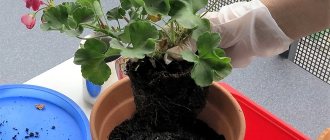In this article we will consider issues regarding the care and planting of gladioli.
Surely, many of us know what a beautiful flower looks like – gladiolus. Speechweed, as this crop is also called, really cannot help but attract flower growers with its lush color and variety of species.
However, not all gardeners and gardeners are in a hurry to plant these plants on their plots, because they believe that caring for them requires a lot of effort. Whether this is true or not, today we will try to figure it out.
When to prepare gladioli for planting in the spring, take them out of the refrigerator for germination: timing
Gladioli cannot be called too picky flowers, however, they, of course, need some care.
Let's start, perhaps, with preparing flowers for planting in spring:
- First you need to remove the gladioli from their storage place - the refrigerator. This should be done about a month before planting in the ground.
- Next, you should look at the condition of the corms. Be sure to clean them of scales. This must be done extremely carefully, as the eyes of the plants can be damaged. Then we take brilliant green and treat all the “wounds” of the crop with it.
- After this, you can move on to the next job. If you have corms that have formed a pair of eyes, you can divide them. They do this, of course, very carefully, and the damaged area is necessarily treated with either ash or activated carbon in tablets, which must first be crushed.
- Further, if desired, you can sort the flowers according to different criteria: variety, size, age.
Preparing the bulbs
- All corms that are unsuitable in your opinion need to be selected and eliminated. Dry, rotten, blackened corms are definitely not suitable for planting.
- Now we carefully put the gladioli in a box or box and send them to a fairly bright place, but without direct rays of the sun. It is better to use a box made of cardboard.
- When laying corms, pay attention to their position. The eyes should not be pressed against anything, otherwise they will grow crookedly. Each bulb should take its place and not lie on top of another.
- That's all, the gladioli are prepared for further planting. Now you need to wait for the right time and temperature and start planting flowers.
What soil is needed for gladioli, what kind of soil do gladioli like?
Particular attention should be paid to the soil in which the flowers will be planted, because if it is chosen incorrectly, the crop will not take root and, accordingly, will not bloom.
- This crop responds well to black soil, which is rich in humus. It is also suitable for light loamy and sandy soils.
- The acidity of the soil in which gladioli will be planted should be neutral or weak.
Soil for flowers
- If the soil is not suitable, most often it is improved, and only then flowers are planted in it.
- If the soil is heavy clayey, it is worth adding weathered peat, if the soil is sand - humus.
How to prepare, divide, clean and what to soak gladioli bulbs in before germination?
Having taken the flower bulbs out of the cool place in which they were stored, you need to immediately start processing them.
- Earlier we talked about the fact that all corms must be cleared of scales. It is necessary to do this, because various parasites and pests can live in them. To clean the children, you need to take them in your hands, lightly press the film, and then pry it with your fingernail and remove it. Clean them immediately before planting.
- It is not at all necessary to divide the bulbs, but almost all gardeners do this. To do this, you need to take the onion that has 2 growth buds and divide it into 2 parts. Treat the cut area with ash or coal.
Before planting, it is important to prepare the bulbs
- An important step in preparing gladioli is soaking them. To do this, you need to place all the bulbs in garlic infusion. Prepare the infusion as follows: peel and grate 270 g of garlic, then pour 10 liters of water into the vegetable. We place not only adult bulbs in this liquid, but also children, and wait a couple of hours. Garlic disinfects gladioli and affects various pests.
- If the option with garlic does not suit you for some reason, use solutions of potassium permanganate and karbofos. First you need to carry out the procedure with a solution of potassium permanganate. To do this, dissolve 1 g of the product in 10 liters of water and dip the onions in the resulting liquid for half an hour. Afterwards, dissolve 25 g of karbofos in 10 liters of water, and put the plants in this solution for half an hour.
- After all such manipulations, you can treat the crop with means that will accelerate its growth. To do this, add 1 tablet of heteroauxin, 1 g of sodium humate and 1 g of succinic acid to 10 liters of water. Plants must spend at least 8 hours in this liquid.
Description of culture
Varieties of gladioli.
Photo from pixabay.com To grow these beautiful flowers in your garden, first of all you need to know everything about gladioli!
Gladioli (gladiolus in Latin, derived from the word gladius - sword), or Swordweed - is a genus of perennial corms of the Iris family. Gladioli flowers get their name because their leaves resemble small swords: according to ancient Roman legend, the first gladiolus flower grew where two gladiators, who refused to kill each other, stuck their swords into the ground to the hilt.
Perennial gladioli grow in the regions of Asia, Mediterranean Europe and South Africa. This relatively unpretentious plant blooms from the very first weeks of summer until the first days of autumn, and lives for about 4-5 years. Next, we will talk in detail about how to grow gladioli that will delight the eye throughout the summer season.
Gladioli sprouted in January, February, March: what to do?
Due to improper storage, the bulbs of this crop often germinate before the required time.
- The thing is that gladioli, during their forced rest, go through 2 stages: the first stage is the time during which the flowers are at rest for reasons beyond our control, the second stage is the time during which we provide peace to the culture, creating certain conditions for her
- By conditions we mean air temperature of about +10 degrees and humidity no more than 70%
When the storage conditions of the crop are violated, we get flowers that sprouted in winter. In this case, the algorithm of actions should be as follows:
- We carefully transfer all the corms to a drier place. This place should be warm enough. In a few weeks the plants will dry out properly.
- After this, we take the corms and transfer them to a place where the air temperature will not exceed +6 degrees. The humidity in this room should be lower than normal.
- A couple of weeks before planting gladioli, they need to be moved to a room with a temperature of about +15 degrees. Such conditions will contribute to the awakening of culture.
It is not recommended to plant prematurely sprouted flowers in the ground, since they, in principle, will not yet be able to take root and grow normally.
Bulb storage rules
For a month or two I store the onions in the coolest place in the apartment - on the windowsills or near the balcony sash. Then, after 45-60 days, until spring I move it to a vestibule or an unheated loggia. An alternative is ventilated basements and cellars, the bottom shelf of the refrigerator.
When storing I follow the following rules:
- I don’t use plastic bags - as a last resort, I buy perforated ones or make holes in them myself. It is best to wrap it in paper or newspaper and place it in a cardboard box or plastic container.
- I take the container into storage with a temperature of 3-5 ° C, air humidity within 60%. At higher temperatures, the corms will germinate, and at higher humidity, they will rot.
- To prevent infection and rotting of the corms, I place them mixed with peeled garlic cloves.
- At the first signs of mold, I lubricate it with brilliant green or sprinkle it with Fundazol powder.
Now you know how to grow royally blooming and healthy gladioli in your garden. These magnificent flowers do not require specific care and are unpretentious in structure and fertilizer composition. The main thing for them is sufficient lighting, stable watering that does not turn into waterlogging. Do not forget about timely gartering, hilling and prevention of diseases and pests.
What to do if a gladiolus sprout breaks?
Very often we order new varieties of crops from various online stores. At the same time, the transportation of flowers often leaves little to be desired. And in everyday life it happens that the sprouts of culture break. If this happens to you, it is important to know the following information.
- Most often, good healthy bulbs have so-called spare buds
- If you create conditions that are comfortable for the plant, it will survive and after planting it will definitely delight your eye with lush flowering
- If there is still a lot of time before planting in the ground, place the onion with the broken sprout in a fairly cold and, most importantly, dry place
- If you need to plant the crop very soon, then the bulb with the broken sprout should be left in a warm, bright place. This is necessary so that the spare kidneys begin to wake up faster
In any case, do not rush to throw away the plant, try all available methods and only then make a decision.
Preparing bulbs for planting
You can remove gladiolus bulbs from the place where they were stored in the second half of March. The remains of the bottom, as well as dry covering scales, are removed from them. Peel the bulbs carefully so as not to injure them.
All bulbs with signs of bacterial or fungal disease should be thrown away. If this is not done, the disease may spread to other gladioli, and then you risk losing all the planting material. If the variety is extremely rare or very expensive, you can try to save the bulb, but you need to keep it away from all other specimens.
Take a disinfected, very sharp tool and use it to cut out all the affected areas. The cut areas are burned with ordinary brilliant green. If there are several diseased bulbs, then after treating each of them, wipe the instrument with alcohol or a pink solution of potassium manganese.
In order to stimulate growth, in the last days of April, immerse the planting material in a special nutrient solution for 10–12 hours.
To prepare it, dissolve a pinch of potassium manganese, ammonium molybdate, magnesium sulfate, boric acid, zinc sulfate and copper sulfate in a liter of well-settled water. Thanks to this treatment, the plant will bloom 15–20 days earlier than expected; in addition, their flowers will be larger and the bushes will be more powerful.
Many experts also recommend that before planting, soak gladiolus bulbs in a solution of a special preparation that stimulates the growth and formation of roots (prepare the solution according to the instructions). The onions removed from the solution are laid out in one layer and left to dry for a day.
To protect gladioli from diseases and harmful insects, you will need to carry out preventive treatment of planting material immediately before planting. To do this, dissolve 50 grams of Fundazim or Maxim in two liters of water and immerse the onions in it for a couple of hours.
In Siberia, as well as in the northern regions, gardeners often sprout bulbs so that they bloom earlier than usual. To do this, in a warm (at least 30 degrees) place with low air humidity (about 60%), place the onions with their bottoms down. This must be done 7–15 days before disembarkation (approximately mid-April). By the time of planting, the hatched bulbs will grow a shoot from 50 to 70 mm long. Such bulbs are planted in the soil in the same way as non-sprouted ones.
Time to plant gladioli in open ground in spring: month, air temperature
In order to choose the right time and month for planting a crop, it is recommended to pay attention to the weather outside the window.
Most often, nature itself tells flower growers when it is time to plant plants.
- If the spring is early and warm enough, gladioli bulbs can be planted at the beginning or end of April.
- If spring is not as warm as we would like, then planting should be postponed until the beginning of May, or even its first week.
Planting bulbs
- You can navigate by folk tips. If small leaves begin to form on the birch tree, this is a sure sign that the bulbs can be planted.
- You also need to focus on the soil temperature. The most suitable soil is considered to be one that has warmed up to +10 degrees. The depth of the soil being tested is about 12 cm.
Choosing a location on the site
Bright blooming gladioli. Photo from pixabay.com
Gladioli are plants that require bright light to grow healthy, so it is best to choose an unshaded location with good sunlight.
It is preferable that the selected area is not blown from all sides - the tall thorns of gladioli do not like the wind.
There are certain requirements for the soil. Gladioli prefer light soils: black soil with a low content of clay and sand. The problem of high clay content in the soil is solved by adding sand to it.
Monitor the groundwater level in the area chosen for planting: if it is too high, then it is better to find another place for gladioli.
It is important!
Gladioli cannot be planted in the same place for 2 years in a row, so take this into account when choosing a planting location.
Preparation and treatment of gladioli bulbs against thrips before planting in spring: means, description
Thrips are special enemies of flower growers, as they cause considerable harm to many crops.
To save gladioli from these pests, use these methods.
- Before planting, you need to take the plants and place them in fairly hot water - 50°C. You can keep gladioli in such water for no more than 3-5 minutes.
- You can also treat the culture in Actellik solution. This product has a complex effect on all parts of the plant, destroying many pests. At the same time, the product is safe for flowers and can be used with other drugs. To prepare the required solution, take 10 liters of water and dilute 15 g of the product in it.
Bulb processing
- You can use a folk remedy, which, according to flower growers, is no less effective than special means. We take 800 g of garlic, peel it, pass it through a press, collecting the juice. Dilute the resulting juice with 10 liters of water. Dip the plants in this solution for 1 hour before planting.
- It is also recommended to disinfect the crop bulbs with karbofos. Take 10 liters of water and dissolve approximately 50 g of the product in it. Immerse the plants in the solution for 5 minutes. The procedure must be done immediately before landing.
- A good remedy is Inta-Vir. To use it, dissolve 1 tablet of the substance in 10 liters of water. Place the plants in the resulting liquid for 5 minutes. After the procedure, we immediately plant the crop.
Optimal size of gladioli bulbs for planting
Many flower lovers are interested in what is the optimal size of gladioli bulbs suitable for planting. In this case it is 3.5-4.5 cm.
Do not buy large bulbs under any circumstances, as they most likely will not produce large flowers. Therefore, give preference to bulbs that are no more than 4 cm in diameter; they should be shiny and free of wrinkles.
Proper planting of gladioli in the spring so that they bloom well and do not fall: depth, planting rules
Planting of this crop begins when the soil warms up to at least +10 degrees at a depth of 10 cm.
Most often, the planting period falls at the end of April, beginning of May. In order for the planting of flowers to be successful, and the gladioli to please you with their flowering, it is recommended to adhere to the following rules when carrying out this process:
- Plant the healthiest, highest quality plant bulbs first.
- Gladioli are planted in sandy soil, because such soil has a beneficial effect on plant bulbs and performs a protective function.
- To achieve a similar effect, proceed as follows: pour a little sand into the holes dug for the bulbs. It will be enough to fill each hole with a layer of sand of 1.5 cm.
- An already planted plant is also lightly sprinkled with sand, and then with soil.
Planting in spring
- When planting plants, keep an eye on the distance between them. If the bulbs of the crop are large enough, then the distance between them should not be less than 15 cm, between the rows of such plants the distance should be at least 20-25 cm. If you are planting children, then it will be enough to make the distance between each bulb 5 cm, and between rows – 15 cm.
- The depth at which plants need to be planted also depends on the soil and their size. If the crop is planted in chernozem or sandy soil, then the depth should be approximately 15 cm, but if the soil is clayey, then it will be enough to plant the bulb to a depth of 8 cm. On average, corms are planted to a depth of 12 cm. Children are planted to a depth of 4 cm.
- Before planting plants, be sure to moisten the soil. However, do not turn the hole into a small swamp.
GROWING GLADIOLUS STARTS WITH PLANTING
Gladioli corms are most often planted after May 10, choosing the sunniest place for this. Place them in a flowerbed at least 20 cm high so that rainwater does not stand around them. When digging, do not skimp, add compost, sand (one bucket per square meter), potassium-phosphorus fertilizers and stove ash.
Plants do not like acidic and heavy soils. The best for them will be neutral or slightly acidic (pH 6.8 - 7). It won’t be difficult at all to grow gladioli on this one.
Every three years, gladioli are transplanted to a new place, otherwise pathogenic microorganisms will quickly accumulate in the ground. Before planting, the corms are treated with a solution of potassium permanganate or “Fitosporin M” for five hours.
Planting material is sorted by size: large corms - separately, small ones - separately. Otherwise, adult bulbs will take away nutrition from young ones. It is better to allocate a separate flowerbed for each.
Plant the corms at a distance of 16 centimeters from each other.
The depth of the planting hole should correspond to three diameters of the bulb plus 2 centimeters, since sand is placed at the bottom of the hole with just such a layer as drainage. Corms are laid out on it, covered with soil and watered well.
When the first shoots appear, they are once again sprinkled with fertile soil so that they form more adventitious roots. This will ensure the growth of large leaves and the formation of a powerful inflorescence with a large number of buds.
How often to water gladioli?
This crop loves water, so plants must be watered properly. Otherwise, the root system of plants may be damaged, and this in turn will affect the development of flowers.
- Watering is carried out exclusively with warm water. Cold or even cool water is not suitable for watering this crop.
- Gladioli do not need frequent watering, however, there is no need to skimp on water when watering the plants. The soil should be moistened to at least 25 cm in depth, or even to the full 30 cm.
- For each plant you need to use about 10 liters of water.
- The amount of water used also depends on weather conditions. If the weather is hot outside, the amount of water can be increased by 1.5 times.
- After the procedure, it is recommended to lightly weed the soil and loosen it.
Can gladioli withstand spring frosts?
It should immediately be noted that gladioli are heat-loving crops, so temperature fluctuations have an adverse effect on plants.
- It is generally accepted that air temperatures from +17 to + 25°C are most suitable for the normal growth and development of this crop.
- It is also important to consider that nighttime cold snaps have a much greater effect on plants than daytime ones.
- Plant roots feel good at a soil temperature of +10°C.
- During the growing season, the crop may suffer if the air temperature drops to -4°C.
- Spring frosts are dangerous for gladioli. If the plant stays for about 8 hours. at a temperature of -5°C, its leaves will suffer, however, not critically. If the temperature drops to -7°C, then during the same time the flowers will die.
- In order for plants to tolerate frost as best as possible, they need to be hardened off in a timely manner. This procedure will significantly reduce the risk that gladioli will not survive spring frosts.
Planting dates for obtaining gladioli seedlings
To grow gladioli seedlings, timing is also important. Typically, gardeners focus on local conditions and the characteristics of further flower growing. For example, in northern regions and in the presence of a heated greenhouse, some varieties of flowers can be planted as early as March.
To find out when is the best time to plant gladioli seedlings, visit local nurseries and talk to gardeners. They are usually willing to share such subtleties and give recommendations on the optimal timing and type of flowers.
Keep in mind that when growing gladioli early for seedlings, you will need to organize additional lighting.
How to feed gladioli when planting, in spring, during flowering: fertilizers, folk remedies
Fertilizing plants plays a huge role, because in this way the flowers receive all the microelements and substances they lack.
- Initially, fertilize the soil in which gladioli will be planted. To do this, urea, ash, potassium sulfate and superphosphate are added to the soil. For example, you need to take approximately 45 g of ash per 1 m2, if the choice fell on urea, then 30 g will be enough, potassium sulfate is used in an amount of 20 g, and superphosphate - 30 g
- Next, the plants themselves are fed. As soon as the second leaves appear on the crop, you can fertilize it with chicken droppings. To do this, prepare a solution based on a ratio of 1:20. Also, the first fertilizing can be done using nitrophoska. To do this, dilute 50 g of the product in 10 liters of water. Leave this liquid for a day, and then fertilize the plants with it.
Next, we will feed the gladioli when 5 true leaves appear on them. For this fertilizing, add the following components to the soil per 1 m²:
- Ammonium sulfate – 15 g
- Superphosphate – 15 g
- Potassium sulfate – 15 g
Feeding
As soon as a peduncle appears on the plant, it is time to make the next feeding. For this stage, it is recommended to take the following substances per 1 m²:
- Urea – 7 g
- Superphosphate – 30 g
- Potassium sulfate – 25 g
- Final fertilizing is carried out after the crop has flowered. It is appropriate to water the flowers with a solution of wood ash. To do this, dilute 1 glass of the substance in 10 liters of water.
Before buds begin to form on the plants, it is recommended to spray. To do this, mix the following substances:
- Boric acid – 1.5 g
- Copper sulfate – 2 g
- Cobalt nitrate – 1.5 g
- Zinc sulfate – 1 g
- Liquid soap – 15 g
- Water – 10 l
We spray the flowers with this solution so that the liquid gets onto the entire plant. For the procedure, choose the evening time.
Caring for gladioli in spring
To ensure abundant flowering, planting gladioli bulbs correctly is not enough. They need to be well looked after in the spring, especially if the planting hole has not been filled with fertilizers.
Watering
To develop flower shoots, gladioli in open ground need systematic watering. The bed is irrigated every other day, and the water norm is more than 10 liters per 1 square meter. m. However, if the weather is rainy, then watering is stopped completely. It is enough to loosen the flowerbed several times a week. During dry periods, water daily.
Experienced gardeners recommend watering not the plants themselves, but the spaces between the rows, so as not to provoke rot. The roots of gladioli are powerful; they will independently obtain the required amount of nutrition. In addition, it is better to water in the evening, when the heat subsides. The water is pre-settled.
Top dressing
Fertilizing plays an important role in the development of flower stalks. They are carried out several times a season according to a certain pattern:
- during the formation of the second sheet, add 1.5 tbsp. l. saltpeter;
- at the stage of the 3-4th leaf, give 1 tbsp. l. urea and potassium sulfate;
- when the 5-6th leaf is formed - 2 tbsp. l. potassium sulfate and 1 tsp. urea;
- during the budding period - mineral water-soluble complexes;
- after flowering – 1 tsp. potassium monophosphate.
All fertilizer rates are calculated per 1 square meter. m. This scheme contributes to the growth of good green mass and a large peduncle.
Mineral fertilizers in the spring should be alternated with organic matter. It is applied in liquid form and after watering. You can only use bird droppings; manure should not be added to gladioli in open ground.
Disease Prevention
Gladioli in open ground rarely get sick, but for this you need to observe crop rotation. They are not planted in one place for 2 years in a row. You cannot grow these flowers after tulips, asters, and dahlias. They have similar diseases, so gladioli are at risk of getting fusarium.
Calendula and marigolds repel pests and decorate a flowerbed with gladioli. They prevent the appearance of thrips, which eat flower stalks in open ground.
But even such measures do not guarantee that gladioli in open ground after planting in the spring will not get sick. Therefore, the soil is treated several times with fungicides or preparations with copper. For pests, infusions of celandine or tobacco and approved insecticides are used.
Loosening and weeding
Gladioli do not need proximity to weeds. They draw nutrients from the soil, which negatively affects flowering. The soil is regularly weeded and loosened in the spring. It is better to do this after watering or rain.
Advice! Weeding and loosening in open ground is done once every 10 days to ensure access of oxygen to the roots.
Garter
Gladioli in open ground produce tall flower stalks, which often reach 1.5 m. That is why they must be tied to supports, otherwise gusts of wind will break the flowers. You can tie up each plant, if there are only a few of them. To do this, wooden stakes are installed next to the gladioli.
When a lot of gladioli are planted in open ground in the spring, it is advisable to install supports along the beds and stretch a wire that will prevent the flower stalks from falling.
Low-growing varieties of gladioli that are planted along the fence do not need to be tied up.
When do gladioli bloom, in what month?
The flowering period of gladioli directly depends on when you planted them in the ground.
- Some gardeners plant this crop in mid-March. Gladioli planted at this time will delight you with their flowering around the first week of July
- Plants planted in mid-April will bloom in late July
- If you planted the plants at the end of May, then you need to wait for them to bloom around the last days of August
- And those gladioli that went into the ground at the end of July will delight you with color no earlier than mid-September, or even in early October
Knowing this information, you can adjust the time of planting flowers, so that you can admire them all summer and even a little bit of autumn.
When and how to dig up bulbs
Perennial gladioli are planted in a flowerbed in the spring, but they must be dug up in the fall, since they do not overwinter in open ground. This is not done immediately after flowering, but after 4-6 weeks. The stem must dry out on its own so that the nutrients go down into the bulb, then it will overwinter well.
The timing of harvesting gladioli in different regions does not coincide. Somewhere they are dug up in mid-September, and sometimes in the second half of October. However, there is no need to delay cleaning.
Dig up flowers following step-by-step instructions:
- Undercut the plants so as not to damage the bulbs or cut them.
- To chicken out the remnants of the earth and separate all the new children.
- Rinse the planting material in clean water.
- Carefully separate the dry bottom, as it is not needed for storage.
- Remove any remaining roots and stumps.
- Rinse the planting material again in clean water, then soak in a solution of any fungicide. It should be diluted strictly according to the instructions. Processing time 15 min.
After processing, dry the planting material and prepare it for further storage. To do this, it is dried in a well-ventilated place at a temperature of +25°C for 2 weeks. During drying, avoid direct sunlight.
After drying, the gladioli are removed for 6 weeks in a cool place where the temperature will not drop below +20°C. Ventilation in the room should be good. Only after such events can we consider that the gladioli are completely dried and ready for winter storage.
Gladioli after flowering: what to do, how to prune gladioli for the winter, how much stem to leave?
The gladioli have faded, however, they still need care and attention. After all, proper cleaning of plants after they bloom is the key to their successful storage and future flowering.
- After the crop has flowered, proceed as follows. After about a month, 40 days, the gladioli need to be dug up. This must be done extremely carefully so as not to damage the root system of the plants. First, the plants are slightly dug up, prying them up with a pitchfork, and then pulled out with their hands.
- Now we remove the remaining soil from the flowers and lay them on a dry surface. In this case, immediately inspect the dug up bulbs. All sick, damaged bulbs should be removed to the side. The stems of the crop should be trimmed as much as possible. It is permissible to leave only a small piece of the stem, approximately 5 cm
- Leave the plants for a couple of days for them to dry out.
- After this, we treat the gladioli in a solution of potassium permanganate. Then dry it again
- Then the plants need to be stored in nylon bags for a whole month.
- After this time, transfer the bulbs to a box and store it for about a month.
- After this, the culture must be moved to a cold place.
- You need to dry gladioli monthly, taking them out of the basement or refrigerator
- While doing this procedure, inspect the plants for pests and diseases.
Diseases and pests
Gladiolus, like other bulbous plants, is very vulnerable to fungal diseases. This plant is also afraid of viruses. Root rot and fusarium can be prevented by carrying out preventive treatments and treating tubers with fungicides.
Tubers can be damaged by thrips and root mites. Therefore, after removing the bulbs from the soil, the seed is subjected to mandatory pickling, first in a solution of “Fundazol”, and then with potassium permanganate. For slugs and mole crickets, traps or special preparations should be used.
Author of the article: Polina Viktorovna Kolesnikova
Tags: perennials
- Related Posts
- Poinsettia domestica - a Christmas flower of unusual beauty: planting, care
- Perennial flowers for the garden, the beauty of which will take your breath away - name, description, photo
- Rare indoor plants for the home - name, description, photo
« Previous entry
What to do with gladioli babies in the fall?
The only thing we can say for sure is that you definitely shouldn’t throw them away.
- Having dug up the plant bulbs and cleared them of soil, we leave them to dry
- After this, it is necessary to separate the children from the main bulb. To do this, you need to carefully unscrew them.
- Adult and baby bulbs should be stored separately.
Gladioli babies
- In this case, the children need to be folded into paper and then into cardboard boxes.
- The best places to store them are in a cellar, balcony, or refrigerator.
- The temperature in the room where children are kept should be about +5 degrees
Digging up gladiolus bulbs for storage: timing and processing technology, storage methods
When should you dig up gladioli?
There are early and late varieties. Accordingly, the ripening of the bulb can occur in early and late periods, depending on the variety.
Advice! About when to dig up gladioli bulbs and how to store them is written in detail in this article .
Thus, now you know what you need to do to grow a wonderful, magnificent gladiolus flower in your summer cottage without any problems. Isn’t it true that even a novice florist can cope with all the requirements for caring for a flower.
Video: planting gladioli bulbs
Reproduction of gladioli by children: description
Propagating gladioli by children is the surest way to provide yourself and your garden with beautiful flowering crops.
- In the fall, as you already know, the children are separated from the mother bulb, and, properly processed, stored until spring
- Next, before planting, the children need to be treated. First, we clear them of scales. After this, we make a solution of potassium permanganate by mixing 10 liters of water and 5 g of the product. We treat children with this liquid
- We plant children only when the soil temperature at a depth of 10 cm is +10 degrees
- Plant plants to a depth of 5 cm
- Between plants you need to leave a distance of 5 cm, between rows - 15 cm
- As soon as the shoots appear, it is necessary to water the plants and loosen the soil
- You can fertilize gladioli a month after you see the shoots
- It happens that children shoot arrows and bloom, but this should not be allowed in the first year
- Around the end of September, the bulbs need to be dug up and then prepared in a way already familiar to you for storage.
Treatment of bulbs before planting
Processing gladioli bulbs before planting involves clearing them of excess husks. Unnecessary growths and spots are cut out with a knife not only from partially rotten new bulbs, but also from those that need renewal and reproduction. After the pruning procedure, it is necessary to leave at least one living bud of the plant tuber.
This is especially true for elite varieties of gladioli. Dip the damaged areas in tree resin. Let the bulbs recover a little by leaving them in this state for several days.
Among the most effective methods for treating gladiolus bulbs before planting
- highlight:
- placing the bulbs in a solution of potassium permanganate;
- the use of growth stimulants, which are used for indoor plants and flower beds;
- many experienced gardeners prefer to scald the bulbs with boiling water and then rinse them in cold water;
- a solution of microelements is used, it is more effective than boiling water, but not so safe for the condition of the bulb itself.
How to get gladiolus seeds?
This crop can also be propagated using seeds. To do this, you need to get seeds, and this happens as follows.
- The plant must be pollinated by pollen from another flower.
- After the gladioli have faded, the process of drying begins
- When the flowers dry, small boxes with seeds will appear in their place.
- Our task is to remove the boxes and collect the seeds
When we have the seeds at hand, we can think about propagating this crop with their help.
- The process of growing a crop from seeds begins at the end of winter
- We take our seeds and soak them in a solution of sodium humate (a 0.01% solution is suitable for this) for a couple of hours.
- Next, mix humus and sand in a 2:1 ratio. We plant seeds in this soil
- Next, we care for the seeds in the standard way: water them, feed them if necessary
- If the weather in your region allows, plant the seeds directly in open soil.
- When the season is over, your seedlings will delight you with the appearance of children
- We carefully separate the babies from the stem, dry them and put them away for storage.
- Store in a fairly dry and warm place
Digging up gladioli bulbs
It is necessary to dig up gladiolus tubers a month to a month and a half after the plant has stopped blooming. However, in the northern regions of the country, gladioli bloom late, so the bulbs do not have time to ripen during this period.
It is necessary to remove plants only in dry weather, because otherwise, wet soil will stick to the bulbs, and this will create additional difficulties. In addition, wet soil will make it difficult to harvest the bulbs, which become heavier.
Be careful! Keep in mind that if the tubers accidentally tear off the stem and remain in the soil, then this risks the fact that in the spring there may be a mixing of the varieties of grown gladioli, which will lead to the area quickly becoming clogged. Under no circumstances leave the bulbs in the ground; be sure to remove them!











